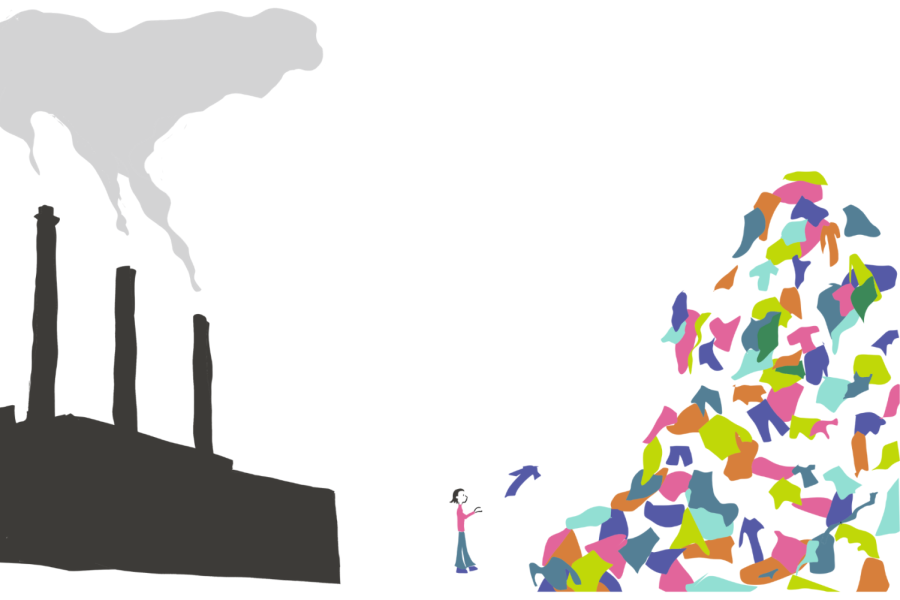Guilt off the rack
Addressing the guilt students face from fast fashion
March 18, 2022
It seems like every other week, there is another fashion trend blowing up our Instagram feeds, For You pages or at school. Between baggy jeans, sweater vests and the resurgence of 2000s fashion that has gained popularity in the past couple of years, it’s clear that fast fashion plays a key role in students’ clothing choices.
Fast fashion is defined as an approach to the design, creation and marketing of clothing that emphasizes making trends quickly and cheaply available to consumers. This speedy distribution of clothing which marks trends as being “in” or “out” motivates various young people to buy more cheaply made clothing for instant gratification.
For many MVHS students, conversations surrounding the morality of fast fashion retailers have been circulating, encouraging students to disengage from the inexpensive and “trendy” styles and prioritize sustainability.
While junior Lourdes Diaz follows recent clothing trends, her style gravitates towards a “Dark Academia” aesthetic. She notes that Instagram trends influenced her choice of collared shirts, hats and ties. She says layering is an integral part of her style.
“When I say layering, I mean different textures of clothing, not necessarily wearing multiple jackets,” Diaz said. “Layering different textures like lace, corsets and jewelry. I think that jewelry has become very important in my fashion.”
Junior Ankita Chaugule credits the constantly changing fashion industry for her urge to buy clothing as soon as a new trend comes out. However, while she would previously check out websites like Shein after seeing others find jeans for as low as $7, she now looks towards sales in malls at some of her favorite stores such as H&M and Zara.
“[Sales perpetuate fast fashion] because if I’m getting jeans for $9.99, why would I pay $50 anywhere else?” Chaugule said. “The cheap jeans could be of the same quality [as the $50 jeans] but it might not be, which is probably why it’s on sale.”
On the other hand, junior Darpan Singh does not feel guilty for shopping at fast fashion retail stores in the past, due to purchasing clothing that isn’t a part of temporary trends. Longevity of clothing is of importance to him and he believes that people should purchase clothing that they can use for a long time.
“I bought a hoodie at H&M a year ago and I still wear it,” Singh said. “So for me it’s not really fast fashion. [Fast fashion retailers] also sell stuff that’s super plain and the hoodie that I’m talking about is just like a plain blue hoodie, but there’s definitely stuff that I can tell is trendy now and won’t be trendy later.”
In recent years, Chaugule has acknowledged the harmful effects of the fast fashion industry including clothing waste and the exploitation of migrant workers, and thus, has changed her shopping habits by investing in key pieces of clothing that can be worn in a variety of ways and that can sustain her for a long period of time. However, while she feels that choosing to buy from small businesses that are more environmentally-friendly should be everyone’s goal, they lack the convenience and affordability of fast fashion.
“I feel like there’s no real way to alleviate or remove the problem of fast fashion,” Chaugule said. “They’re low prices because they’re mass produced, and with these, small sustainable brands, it’s not that easy for them to mass produce, which is why it’s more on the pricier side. So I still would gravitate towards fast fashion.”
Additionally, Diaz states that some people refute that fast fashion benefits those with a lower socio-economic status. However, she thinks that those who are better off tend to shop at fast fashion retailers more often due to them being able to afford the temporary nature of the clothing.
“Clothes produced by fast fashion don’t last long, because they’re cheaply made,” Diaz said. “It wouldn’t make sense for low income families to invest in cheaply made clothes.”
Furthermore, Diaz considers fast fashion a tricky issue as she believes that intent for purchasing clothing matters. She feels that it is important to take into account whether buying cheap apparel is worth the ill-effects of fast fashion. Such effects include increased child labor, wage exploitation, fossil fuel emissions, and wastage pile-up.
“No one should die for fashion and there’s a lot of workers who are dying because of it,” Diaz said. “Even though people can afford it doesn’t mean it’s worth [workers] dying for a cute piece of clothing.”















